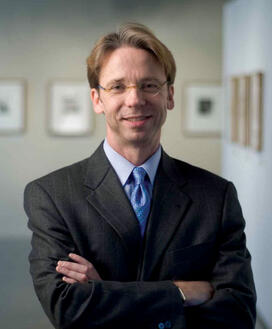
James Steward, named in January as the new director of the Princeton University Art Museum, brings a proven record in fundraising, facility renovation and expansion, and outreach to students — areas on which Princeton must focus as it moves forward, according to professor emeritus John Wilmerding, chairman of the search committee.
Steward, who starts work at Prince-ton April 27, has been director of the University of Michigan’s art museum since 1998. During that time, he said, the museum was transformed from a “rather inward-looking space” with a “quiet exhibition schedule” to one that better serves the university and the Ann Arbor community.
Under his leadership, the museum increased its holdings by 3,500 works to about 19,000, and doubled the average number of visitors per year to about 140,000. He led a recently completed $62 million fundraising campaign, which included a $42 million expansion and restoration of the historic building housing the museum’s collections and galleries.
Steward succeeds Susan Taylor, who became director in 2000 and left Princeton last year.
Princeton’s incoming director is the “right fit at the right time,” said Wilmerding, describing Steward as “steady and deliberate” with the energy and experience to make things happen.
Wilmerding noted that Princeton’s museum has “almost excruciating space problems and renovation problems.” The core building is aging; at the same time, the collection is growing and the University has put on hold the construction of a storage facility at the Forrestal campus and a museum satellite planned for the arts and transit neighborhood to be constructed south of McCarter Theatre Center.
To help realize future expansion and to endow more curatorships, Wilmer-ding said, fundraising will be key. “One of the things we’re concerned about is finding a new or much broader pool of support” beyond Princeton alumni, parents, and traditional supporters, he said. “Clearly, he can do that kind of thing,” said Wilmerding, pointing to the expansion of Michigan’s art museum during Steward’s tenure.
The search committee also focused on Steward’s experience attracting more students to Michigan’s museum. Princeton, said Wilmerding, needs to do a better job of ensuring that students see the museum as “indispensable to their lives here.”
As he did at Michigan, Steward said, he plans to look at “how well the museum is doing in really pulling students and faculty from across the whole University,” including from disciplines that might appear intellectually removed from the art world. At Michigan, for example, he worked with faculty of the University of Michigan Health System to develop courses to train medical students, interns, and residents in looking closely at works of art — because, he said, there’s evidence that doctors become better clinicians when they hone their observational skills.
A specialist in 18th- and 19th-century European art and culture and an art history professor at Michigan, Steward will be leading a museum at Princeton whose holdings (more than 68,000) are more comprehensive and deeper than those of the University of Michigan. “Princeton’s collections are among the top three in the country — with Harvard and Yale being the two other truly pre-eminent university art collections,” he said.
Steward hopes to make good use of Princeton’s location between New York and Philadelphia to mine relationships with other cultural institutions and perhaps arrange artistic residencies or commission installation projects. He said his experience overseeing the expansion of Michigan’s museum could help him contribute to the design and programming of the Lewis Center for the Arts.











No responses yet